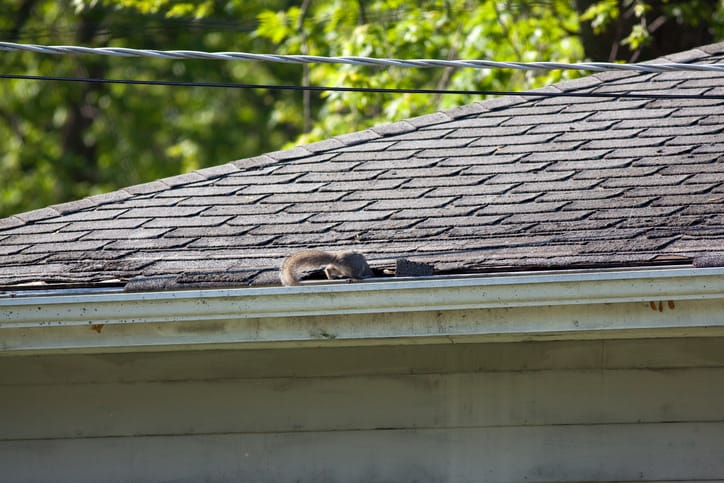While most people think squirrels are ‘cute’ anyone who has had the critters break into the attic would be hard-pressed to agree. Squirrels breaking into the attic can be a nightmare from never-ending scratching and scurrying in the ceiling, destroyed insulation, and the smell that comes with wildlife.
Squirrels are incredibly adaptive and are some of the most successful urban wildlife species. They will break into your attic given the chance and since they can squeeze through a hole 1 ½ inches or more it is only a matter of time before they invade your home if you have squirrels in your area. They mainly break into houses to breed since the dry, warm space offers maximum protection from the elements and predators.

Signs of Squirrels in Attic
It is crucial that you are able to positively identify the wildlife nesting in your attic before you can consider an eviction. Signs of squirrels in your attic include;
Pieces of twigs, leaves and insulation
Squirrels are industrious and like to make a warm, cozy nest breed and sleep in. One of the tell-tale signs of squirrels in your attic is the presence of twigs, small branches and pieces of torn insulation around the attic area. This should prompt you to investigate the attic where you should be able to see the nest.
Noises in the Attic
Squirrels are diurnal meaning that they are only active during the day. You will hear rustling, chewing and scratching sounds in the morning or early evening. You may also hear scurrying as the squirrels go in and out of the nest. Heavy thudding may be some larger animal such as raccoon while activity at night indicates some other nocturnal animal such as bats or rats.
Odours
Squirrel feces and urine odour spread to the rest of the house in no time. The smell is typically a musty or stale odour. Keep in mind that some of the pathogens found in squirrel droppings and urine can be inhaled and contracted which is why you need to take care of the squirrel problem as soon as you are aware of it.
Squirrel Droppings
You are likely to find squirrel droppings near feeding areas such as under the bird feeder, inside the attic or near the attic. Squirrel droppings are oblong shaped and about 3/8 inches long and 1/8 inch in diameter. Fresh droppings are black, dark brown or reddish but fade colour with age. The droppings tend to be thick in the center and smooth and pointy at the edges. Make sure that you combine this sign with others before making a positive identification because it is easy to mistake squirrel droppings with that of other rodents.
Squirrel Activity
There is, of course, spotting the animals scurrying around in your yard or going in and out of the attic. You may also notice destroyed bird feeders, chewed or missing plants and bark and small holes in your garden or flower pots where the squirrels dig to hide nuts.
Stains on the Ceiling
Do not assume that the stains on your ceiling are from water damage especially if you think that you might have wildlife nesting in your attic. It might be that the animal urine has soaked through from the attic. This is a sign of a heavy or prolonged infestation.
How Squirrels Get in the Attic
Squirrels are nimble, intelligent and highly adaptable and have no shortage of ways to get into your house. They will seek any opportunity to build a nest indoors especially if the temperatures drop or there is increased predator activity in your area. Some of the places that squirrels break into the attic include
Roof edge: the roof edge degrades faster than the rest of the roof since this is where rain, snow and vegetation tend to gather. This damage makes easy work for squirrels to chew or rip through and into the attic.
Roof vent: squirrels can easily destroy aluminum or plastic vent covers. The warm air coming out of the vent signals the squirrels that there is a warm, hollow place to nest.
Roof-Soffit intersections: intersections, where the roofs meet, may have a gap if the lower roof and upper soffit shingles aren’t flash together. Squirrels will easily fit through any gap more than 1 ½ inches.
Chimney: the chimney flue is a favourite nesting place for squirrels since it resembles a hollow tree trunk. Squirrels can get trapped inside if the flue is made from a sleek material such as clay or steel.
Hire an Expert to Remove Squirrels from Attic
There is no shortage of reasons why you should hire an expert to remove squirrels in the attic in Toronto rather than attempt to remove the squirrels yourself. There is always the risk of attack where a nursing mother is involved. Rabid squirrels although rare cannot be ruled out.
You should also be careful about sealing entry points into the attic until you are positive that there are no baby squirrels inside. Sealing the litter in means the babies die of starvation or dehydration. The desperate mother can cause extensive damage while attempting to get back into the nest. Older babies may also become desperate and attempt to claw their way out causing serious damage.
